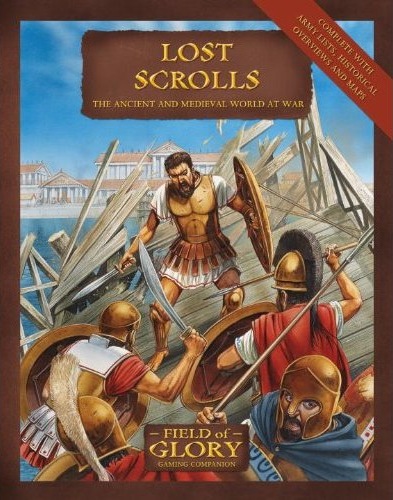
De Re Militari | Book Reviews
Richard Bodly Scott and Nik Gaukroger
Lost Scrolls: The Ancient and Medieval World at War
Gaming Companion 13. Botley, Oxford: Osprey Publishing, 2009. 80 pp. US$19.95/CN$22.95/UK£12.99. ISBN 978-1849-08158-0.
The process of reviewing a book requires not only the evaluation of the quality of the book but assessing the category in which it falls. Is it a text meant for leisure reading, exhaustive study, or scholarly debate? When looking at this particular Osprey volume, it is important to remember that it is a gaming companion and not a military history book. As such, it has no traditional works cited page and only a few internal citations. Nor can provenance for information be established—in fact, much of the information can also be found on Wikipedia, albeit in more detail. The authors, however, do not state their sources.
All of the information in the book can easily be found in many general sourcebooks. The majority of references within the text are from other books in the Field of Glory gaming system and the illustrations are from other books in the Osprey military history series. It is possible that the authors drew their information from other Osprey Publishing sources as the publishing company produces many books in the field of military history. Regardless, there is little specific referencing of material outside a few general references to the Osprey Men-at-Arms series.
As can be seen in the Umbrian commentary (p.16) as well as with the Amorite Kingdoms commentary (pp.41-2) there is an unfortunate willingness of the authors to speculate on military structures for which they do not have adequate historical information. Livy is used several times in a general manner and is not specifically cited. Further, the book rarely goes into any great detail. Due to the nature of the breadth of the peoples covered, this is a good gloss for a text to assist a gaming system; it does not achieve the same as a text needing to display historical accuracy.
There are a great many tables and charts meant to aid the miniature gamer. The tables throughout the book as well as the gaming section at the end of the book is beyond the scope of a military history review, but the need to fit these groups into a gaming framework brings some of the descriptions into question (again, see the Umbrian examples).
If a reader approaches this book expecting solid, clear military descriptions and historical accuracy of the peoples listed, he or she will be sorely disappointed. However, if this book is approached as a gaming reference guide, it becomes a good, solid guide and resource.
Gael GrossmanJamestown Community College <[email protected]> |
and | Emmett GibsonJamestown Community College <[email protected]> |
